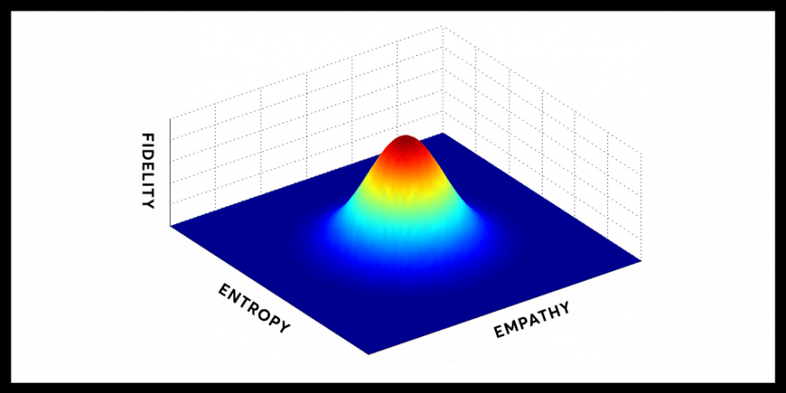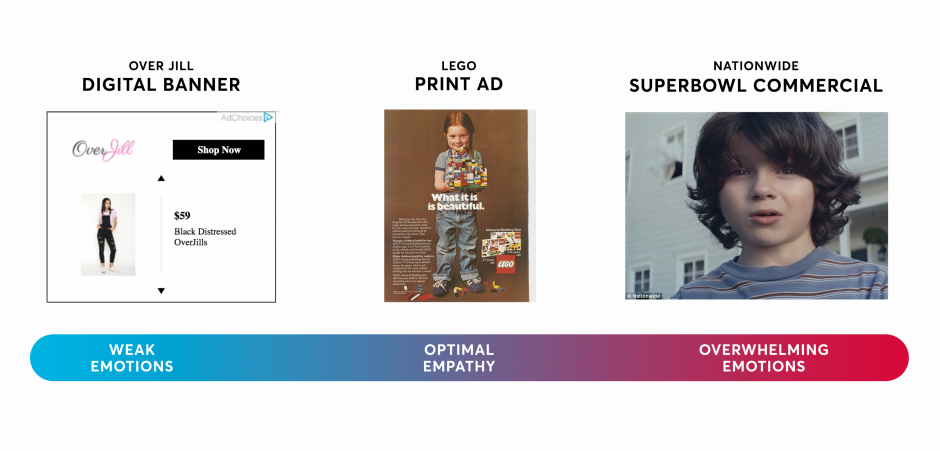As featured on The Drum
Today’s advertising models often focus on outcome-driven KPIs that help to optimize a campaign tactical effectiveness but do little to improve overall strategy.
Missing from these models is the very essence of advertising’s purpose: influencing people through information and emotion. The average consumer sees more than 500 ads per day. Focusing on emotion allows advertisers to break through that excess a grab more than a fleeting moment of a consumer’s attention. Focusing on emotion also allows advertisers to build awareness, change perception, or drive a specific action.
What we need are new models to measure the breakthrough of an ad, quantify whether it successfully transferred its message, and analyze the personal response of the ad.
We can think of these models as: fidelity, entropy, and empathy.

Fidelity
Until you remove the noise, you’re going to miss a lot of signal. – Seth Godin
Ad fidelity: A measurement of how distinguishable an ad’s message is, over and above its canvas; e.g., an Instagram feed, a radio ad, a TV commercial, or an in-article ad.
An ad with high fidelity must be noticeable enough to capture a person’s attention without being abrasive or causing a negative reaction to both the ad and the medium. While that is a fine line to walk, most marketers would agree that capturing a consumer’s attention is the first step in making an impact.
How does one measure ad fidelity? If we think about advertising as a natural occurrence, then a natural pattern should emerge. This natural pattern, known as the Gaussian or Normal distribution, can be applied to our models, based on the following factors:
- How much does the ad resemble the voice and topic of the content?
- How much does the ad share native features of the content (e.g., color, sound)?
- What is the ad's barrier of entry?
Ad fidelity is only the measure of the ad’s “breakthrough” from its canvas, though each canvas will have its own unique distribution that will have to be independently scored.
It’s important to know that this measurement requires elements outside the ad’s control to develop a score. For instance, one ad may have high fidelity on CNN.com, yet the same ad may have low fidelity on ESPN.com. It does not measure anything specifically about the actual message or creative of the ad. That bring us to the next metric.
Entropy
"You should always bear in mind that entropy is not on your side." – Elon Musk
Entropy: How we measure the effective information being delivered to a person.
With such limited time, space, and attention, entropy must be high for an ad to be successful. For example, a 15-second build up in a 30-second video ad is wasted because 90% of the audience has tuned out in the first three seconds. Advertisers must make the most use of this time.
Advertisers must balance the maximum amount of information shared against how much information can be processed by a viewer. Too little information, and the message may not stick; too much information and the message may be forgotten.
With limited time for exposure across all different advertising mediums, the creative must work that much harder to deliver the information effectively. To truly maximize the entropy score, an advertiser should rely heavily on the creative execution and consider these questions:
- How can I maximize brand signaling in the first three seconds of exposure?
- What brand attributes do I want to share with the viewer in the first seconds of this limited time?
- What is the value proposition of the ad message?
- How do we make this message focused?
With entropy, we need to discern whether the message was impactful. Did it manage to convey an emotional response? Namely, can we measure the empathic response of the ad?
Empathy
I've learned that people will forget what you said, people will forget what you did, but people will never forget how you made them feel. – Maya Angelou
Empathy: the ability to understand and share the feelings of another.
By anticipating the emotional feedback from a person, advertisers can make memorable ads that resonate. Tapping into the sentimental state of mind of a viewer is a powerful strategy, but how can we measure empathy? We can begin analyzing the emotional context of an advertisement through the following:
- What is the overall sentiment of the ad? Is it positive, negative, upbeat, sad?
- What feeling does the ad leave you with?
- How intense are these emotions?
- Is there an emotional connection between the ad and the brand?
- Is the brand authentic to the emotion?
We can continue the use of model showing that if an ad didn't trigger an emotion, it did not leave a lasting impression. On the other hand, if a message is too strong, a viewer may actually become overwhelmed and shut it down completely.
Emotional authenticity is vital to the emotional connection of the message. We should aim for the message to hit the empathy sweet spot, where one builds an emotional connection between the brand, the message, and the person. If the message or brand is seen as being fake or ungenuine, while evoking an emotional response, can damage a brand.
Here are three examples of ads fall and the emotional response each elicits:
New ad system
The whole is greater than the sum of its parts. – Aristotle
The current advertising models and measurement techniques focusing on effectiveness take the human factor out of the equation. There is a lack of focus on the residual effect; i.e., a resonance effect that advertising has on a person long after the impression is gone.
The combination of all 3 metrics can give us an optimal ad human score.
Fidelity, entropy, and empathy provide metrics to build a new system. Combining these metrics is the first step to building an ad platform and measurement system that takes the person into consideration. By applying these models into our media strategy and planning cycles, we can expect to see a change in:
- Through fidelity, we increase the ability for the ad to garner a person’s attention without being overly distracting.
- Through entropy, we share only vital information that is relevant to the person.
- Through empathy, we increase a person’s receptiveness to the ad.
Even with the pervasiveness of advertisements, we can still make great strides in advertising measurement and effectiveness. Through this, we will start to cut through the clutter, be precise in delivery, and ultimately, go beyond serving impression to make an impact on each person.


